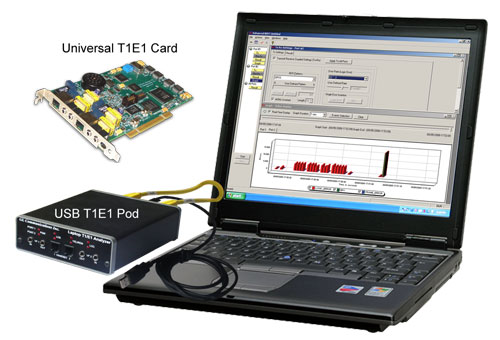GL Enhances T1 E1 Analyzer Products & Software
Welcome to a GL's Newsletter covering latest enhancements introduced to our versatile T1 E1 Analyzer product line. The software has been enhanced, now Version 5.33.

Enhancements Introduced:
The enhancements introduced into T1 E1 Version 5.33 are described briefly below:
- Windows Client Server
- Jitter Measurement and configuration commands have been added
- Error Insertion application
- The application now supports Auto Error Insertion with greater flexibility, with ability to turn on/off auto error insertion, to change error rates with enhanced command set
- Logic errors can now be inserted at a user-determined fixed or random rate; In Auto Insertion Mode, it is now possible to change the rate; Ex., “insert fixed <new rate>”, or “insert random <new rate>”
- Ability to insert logic errors into specific timeslots
- Bulk delay features have been added
- MAPS (Message Automation and Protocol Simulation)
- MAPS-ISDN application now supports 4ESS & Bellcore ISDN standards
- MAPS™ SS7 and MAPS-SIGTRAN applications have been enhanced to support ISUP-CHINA standard, and MAPS™ SS7 is enhanced to support MTP3 protocol as well
- Script Editor changes
- Array Variable option added for Assignment, and IF and ELSE IF Instruction and the Parser to the editor
- GoTo command now includes Message Type as variable
- Variable added for Loop and Wait Instruction
- Implementation of automation of the scripts i.e. Concurrent and Sequential
- Windows Client Server ML PPP Emulator
- ML PPP Echo Test Updates
New tab namely "Link Test" has been added in MLPPP View. Previously Echo Test was only at PPP level, and now it is available at MLPPP Bundle also - IP only compression in IPHC (IP header compression)
Hitherto there was support for IP/TCP, IP/UDP compressions in IPHC. Now there is support for only IP compression - Optional NCP negotiation
NCP negotiation has been made optional with user enabling/disabling the negotiation. This option is available in both PPP and MLPPP Simulation - PPP Multiplexing
As part of NCP negotiation, now the file PPPMuxCP is supported. Once PPPMuxCP is up, multiplexed PPP frames will be transmitted / received - CRTP (Compressed RTP)
RTP compression can be enabled by selecting RTP Compression option in IPHC negotiation. On successful negotiation, RTP compression/decompression will be available - The update also includes NCP termination (Terminate Req/Ack messages) before LCP termination. Once NCP termination is over, LCP termination will start
- MLPPPTerr.ini file has been updated to contain CRTP configuration details like Content Id, RTP Port Range (Start and End range) etc
- Protocol Analyzers
- ISDN Analyzer:
The analyzer now supports new protocol standard and new decode for QSIG-ECMA (Standard ECMA-143 4th Edition - December 2001) - GSM Protocol Analyzers:
- Group Call Control (GCC) protocol (Specification - 3GPP TS 44.068 V9.0.0) is implemented to support VGCS (Voice Group Call Service) feature for GSM-R (Global System for Mobile Communications - Railway)
- Broadcast Call Control (BCC) protocol (Specification - 3GPP TS 44.069 V9.0.0) is implemented to support VBS (Voice Broadcast Service) feature for GSM-R (Global System for Mobile Communications - Railway)
- PPP Analyzer:
PPP Analyzer now includes VoIP Packet Data Analysis to analyze VoIP calls on TDM networks. And it has been enhanced with new decodes to support Compressed RTP and Multiplexed PPP - SS1 Analyzer and Dialer:
SS1 Dialer now supports audio output by activating inward driver loopback and setting the VF Output channel to the one that it’s using. Because this strategy implicitly uses the Rx memory (due to the loopback), a check is made to make sure that the SS1 Analyzer is not trying to use the same Rx memory for its audio input. The two modules must use different timeslots if both are performing audio operations. The titles of both applications now indicate their data source (SS1 Analyzer) or destination (SS1 Dialer). The title bar also indicates whether audio I/O is being used. The code supporting the GL Server’s “set vf insert” commands is consolidated - Multiple Call Capture
With the enhanced application, users can now view PCM files using Audacity software and it can be directly invoked from T1 E1
In addition to the above, there have been many minor modifications and bug fixes to the T1 E1 Software. For more details, please refer to the link what's new in the current version web page.
 Back to Latest News Page
Back to Latest News Page